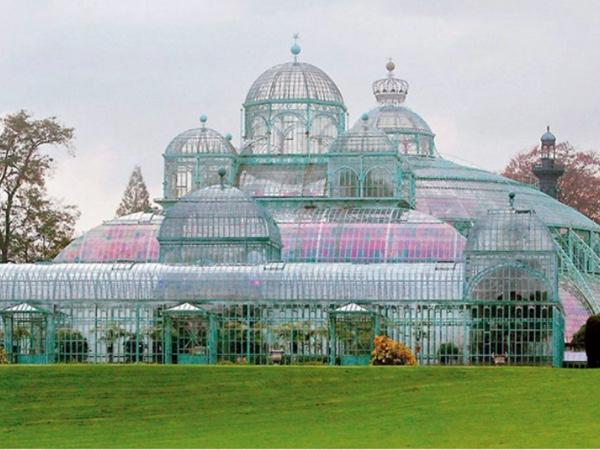This paper was first presented at GPD 2023.
Link to the full GPD 2023 conference book: https://www.gpd.fi/GPD2023_proceedings_book/
Author: Eoin Casserly - VOLUTA, Sligo, Ireland | Faculty of Engineering & Design, Atlantic Technological University, Ireland
Abstract
With increasing concern over plant conservation, there has been a renewed interest in large-scale, enclosed botanical garden structures. Historically, these have been glazed structures, but more recently, synthetic polymers have been used as a replacement for soda lime glass. To create the required habitat for photosynthesis within these structures, there are several critical parameters to be optimized such as Photosynthetically Active Radiation, Visible Light Transmission, Solar Heat Gain, and UV-A & UV-B indices. The cladding material in these buildings should perform favorably within those parameters, while also maintaining the sometimes-competing demands of human comfort during occupancy. The use of glass in these structures is evaluated and compared with other materials, such as ETFE, in promotion of plant growth, along with structural behavior and aesthetics. Geometry also plays a critical role in both minimizing the use of MEP equipment for the internal climate and minimizing the embodied carbon and material usage in the structure. The impact of material choices on geometry are enclosed within the text.
General
Botanic gardens have existed for a variety of purposes since the beginning of plant cultivation. Some of these purposes have been medicinal, scientific, or aesthetic. Approximately 40% of the world’s plant species are threatened with extinction due to habitat destruction, changing temperatures, pollution, and invasive species. This biodiversity loss is not only a crisis for natural systems, but also for human development. 723 plant species used for medicines are among those threatened with extinction. [1]
In addition to their other functions, botanic gardens now also serve a purpose as a hedge against extinction, conserving plant species in areas which may no longer have a functioning atmosphere for their requirements. Controlled Environment Agriculture is a rising field which aims to reduce risk of contamination, use of pesticides and seasonality in agriculture by creating optimal growing conditions in enclosed spaces. Acid rain and insect-borne diseases are other motivations for construction of biome structures.
Since the 1700s, there has been a distinctive architectural typology – single- or doublecurved forms from steel skeletons, with glass used as the cladding material. From historical examples, such as Kew Gardens and the Royal Greenhouses of Laeken, up to current examples on a massive scale, like Singapore’s Gardens by the Bay and the upcoming Oman Botanic Garden. However, the development of Ethylene tetrafluoroethylene (ETFE) has been increasingly used for major large-span projects since its development in the 1970s, with examples such as Eden Project Cornwall and Eden Project Qingdao.
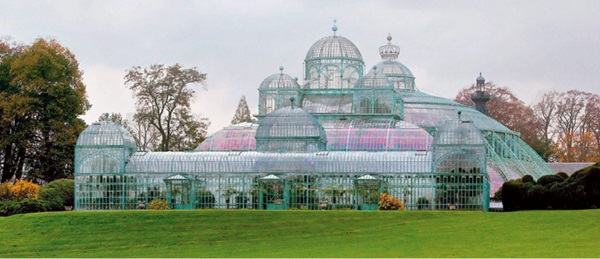
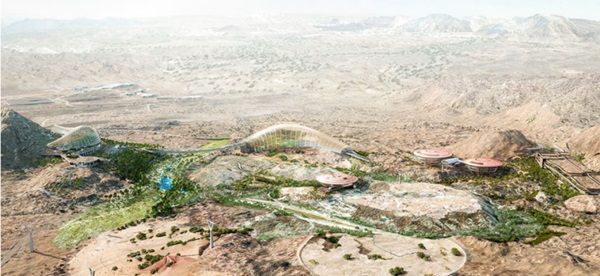
Cladding Materials
Both Insulated Glass Units and ETFE pillows typically have the same function – as a transparent or translucent cladding material. Both use air or a noble gas as an insulating material between the outer layers, multiple layers can be used to improve insulating behavior, and coatings or frits can be used to better control internal climate. They differ in that while the gas layer in IGUs is generally fixed, ETFE pillows are inflated, maintaining a constant pressure, or increasing the internal pressure when external loads, like snow, are predicted to act.
The thicknesses of ETFE layers (12-300μm) are more comparable to those of ultra-thin glass than standard float glass. Consequently, the weight of gladding is much lower for ETFE. The positive Gaussian curvature of ETFE pillows is also a marked difference from flat IGUs.
Biome Structures
Typically, when designing the façade of a building, criteria based on human comfort levels will have to be accounted for. Simulating an exterior environment in an interior space, or attempting to produce the optimal conditions for plant growth in an interior space generally requires the satisfaction of several competing demands, such as:
- Maximizing visible light transmission
- Minimizing Solar Gain
- Humidification or dehumidification
- Heat control
- Shading
- UV transmission
- U-Value
Internal volumes should be open and column free, with roof structure designed to be slender to allow for maximum sunlight.

Light
In comparison with the needs of humans from an enclosure, most plants require orders of magnitude more light. Many plant species are also responsive to certain spectral distributions over others.
When referring to the radiation that is required by plants to generate photosynthesis, the term Photosynthetically Active Radiation (PAR) is used. This measurement is used throughout agriculture, forestry, and oceanography to determine conditions. [2]
The range of PAR light is 400-700 nm, closely matched with the human visible light spectrum (380-780 nm). The most effective wavelengths for photosynthesis are 660-700nm. PAR measurement is preferred over standard methods of measuring light, such as luminous flux and illuminance. Measurements used for human visual capacity are strongly green biased and do not accurately describe the quantity of light usable for photosynthesis.
![]()
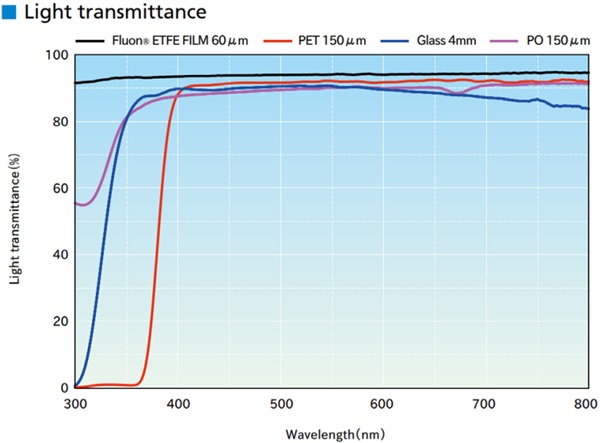
Blue and red light are most efficiently captured by chlorophyll.
If the plants are grown from seedlings within the Biome, there is a separate process called photomorphogenesis which must be satisfied. Photomorphogenesis requires transmission of UV-A and UV-B light. However, excessive UV-B light can also damage plant DNA, with some plants showing a preference for low-UV habitats. [3]
Glass transmits little UV radiation, but most ETFE products can allow 83-88% light transmittance in the ultraviolet range. Because ETFE can transmit most UV light, it is also resistant to UV degradation and discoloration. This transmittance increases solar heat gain which can be reduced by shading patterns on the membrane. For both glass and ETFE, light transmission can be lowered by coatings where desired.
To satisfy requirements, it should be shown that the cladding material can provide the spectral qualities required. However, there is a lack of research on the ideal conditions for many plant species. During the time of construction for the Eden Project, optimum conditions were unknown for 80% of plant species to be housed in the biome. [4] Despite ETFE’s greater capacity for light transmittance over glass, it can have a cloudy appearance, where glass is transparent, giving an important aesthetic aspect to the decision for cladding.
Thermal
The requirement for high levels of sunlight for plant species often conflicts with the need to regulate and limit solar gain in a botanic garden. Natural ventilation should play a role in this balance, but the thermal transmittance of the cladding material is also important. In general, ETFE has a lower U-value than glass, due to low thermal conductivity, high transparency, and the greater volume of air within a pillow compared to an IGU [5]. For both glass and ETFE, Low-E coatings and solar control coatings can influence the energy transmittance of the cladding. Fritting on both can also reduce the risk of overheating a space.
Structural behavior
Insulated glass units and ETFE pillows are different in their structural behavior, with IGUs acting in bending under transverse external loads, while ETFE as a membrane must always be in tension. Glass is brittle and ETFE is prone to creep under long-term loading.
For the Eden project, it was calculated that the choice to use ETFE used less than 1% of the material in terms of volume that a double-glazed solution would have [6]. The relative lightness of ETFE pillows in comparison to IGUs means that less supporting structure is also used.
Geometry
Double-curved forms are typically used for long-span biomes due to their inherent geometric stiffness. This geometric stiffness is required to satisfy the requirement of minimizing structure. The heights of these structures are extremely important since there will be fewer sudden fluctuations in the indoor microclimate with an increased volume. Natural air movement is also promoted with higher structures, due to chimney effects. [7]
Energy
Embodied energy and operational energy must be considered when making a comparison of cladding materials. However, embodied energy is difficult to measure, even for established construction materials. More recent estimates for ETFE than that given in the table below [8] have been eight times higher (210MJ/kg) [9]. Estimates for embodied energy for glass varies depending on processing, especially whether the glass is prestressed.
In a study by [9], similar roofs clad in glass and ETFE were compared in terms of primary embodied energy.
Conclusion
ETFE has many advantages over glass in use as cladding for long-span biome structures, primarily in the areas of light transmittance and weight. However, the development of ultra-thin glass products can go some way to matching ETFE performance, more so than traditional IGUs. These should have a similar light weight to ETFE pillows, while also giving the visual clarity of glass.
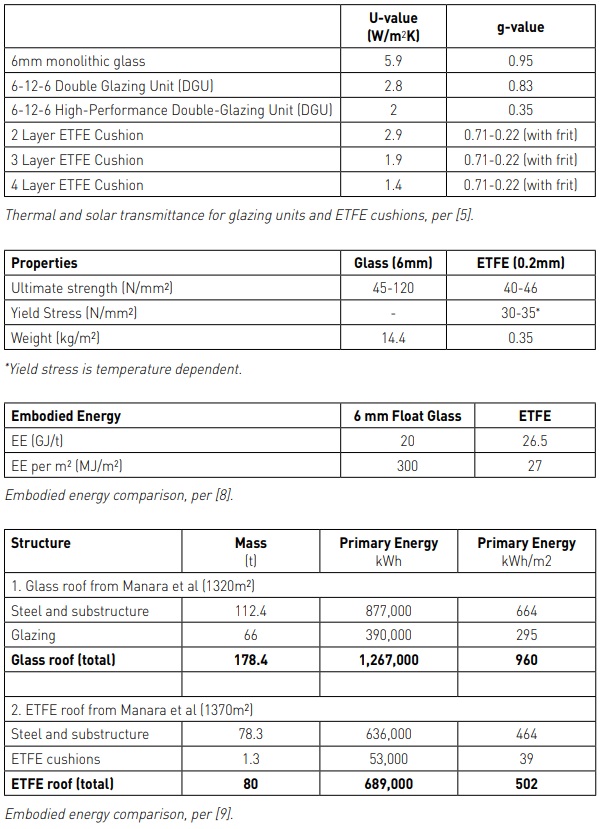
References
[1] Kew Gardens, “State of the World's Plants and Fungi,” 2020.
[2] H. Frohnmeyer and D. Staiger, “Ultraviolet-B Radiation-Mediated Responses in Plants: Balancing Damage and Protection,” Plant Physiology, pp. 1420-1428, 2003.
[3] J. Jacobs, G. Koper and W.N.J. Ursem, “UV protective coatings: A botanical approach,” Progress in Organic Coatings, pp. 166-171, 2007.
[4] P. Thoday, “Planting Environment for the Eden Project,” in Widespan Roof Structures, Thomas Telford, 2000, pp. 85-88.
[5] H. Poirazis, M. Kragh and C. Hogg, “Energy Modelling of ETFE Membranes in Building Applications,” in Eleventh International IBPSA Conference, 2009.
[6] A. Whalley, “The Eden Project Glass Houses World Environments,” in Wide Span Structures, Thomas Telford, 2000, pp. 75-86.
[7] A. M. Syed and C. Hachem, “Review of Construction; Geometry; Heating, Ventilation, and Air-Conditioning; and Indoor Climate Requirements of Agricultural Greenhouses,” Journal of Biosystems Engineering, 2018.
[8] S. Robinson-Gayle, M. Koloktroni, A. Cripps and S. Tanno, “ETFE foil cushions in roofs and atria,” Construction and Building Materials, pp. 323-327, 2001.
[9] J. Fernandez, Emergent Materials for Innovative Buildings and Ecological Construction, Architectural Press, 2006.

